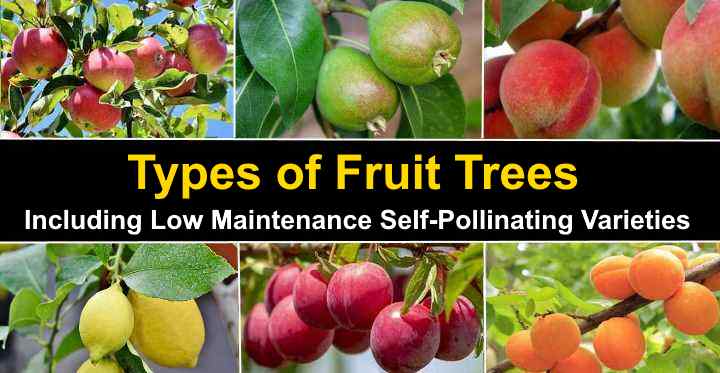You may grow fruit trees of many different kinds in your own yard or even in pots. Dwarf or miniature fruit trees are ideal for small gardens since they don’t take up a lot of area and may be maintained tiny. Self-pollinating (or self-fertile) fruit trees are the best choice if you’re looking for low-maintenance fruit trees.
To produce summer or fall fruit, these trees don’t need other cultivars to be planted nearby. Nectarines, apricots, peaches, and sour cherries are examples of self-pollinating fruit trees.
Apples, peaches, and nectarines are other fast-growing fruit trees that you can choose from. If you want to grow dwarf fruit trees in pots, that’s another option. Dwarf citrus trees are also commonly grown in pots or containers. To create a flourishing outdoor garden or patio full of fruitful trees and plants, read this article and choose the best fruit trees for you.
What Are Fruit Trees?
All types of flowering trees that produce fruit are classified as fruit trees. Fruit trees that provide mature sweet or acidic fruits are the ones that come to mind when we think of fruit tree varieties. Apple trees, pear trees, cherry trees, and plum trees are the most common fruit tree varieties for gardens. Apricots, peaches, and figs are examples of fruit-bearing trees found in warmer climates. Trees that produce berries or nuts are botanically speaking, fruit trees.
Since ripened ovaries with at least one seed are classified as fruit from blooming plants and trees, this is the case. Tomatoes, eggplants, peas, and beans are all different types of fruits in botanical terms because each seed-bearing structure is a fruit.
In the horticultural world, on the other hand, the concept of fruit from a plant is more akin to how we define fruit in the culinary world. Fruits are a succulent kind of plant that is eaten as a snack or dessert, according to certain sources.
Dwarf Fruit Trees
Fruit bearing trees that have been bred to remain tiny are known as dwarf fruit trees. These little fruit trees, on average, reach 8 to 10 feet in height. In tiny gardens or indoors, dwarf fruit trees are the best choices. Others prefer to set pots of fruit trees in their patio. Several dwarf fruit tree types exist, including:
- Dwarf pear trees
- Dwarf plum trees
- Dwarf apple trees
- Dwarf citrus trees such as lemon, lime, orange, grapefruit, and tangelo
Types of Fruits that Grow on Trees
Fruit is a significant source of nutrition for animals, and there are several kinds of fruit that grow on trees. Fibers, vitamins, and minerals are frequently found in tree fruits. Let’s take a quick look at the different types of fruits that grow on flowering trees.
Pomes Core of many seeds in fleshy tree fruits. Apples, quinces, and pears are some of the most popular fruit trees for backyards because they are examples of pome fruits.
Drupes Succulent fleshy fruits with a big seed in the centre are referred to as succulent fleshy fruits. Cherries, peaches, apricots, and nectarines are some of the drupes that grow on trees.
Hesperidia They are a hybrid fruit that includes citrus fruits. In warmer climates, fruit trees such as lemons, limes, oranges, and grapefruit are common.
Types of Fruit Trees With Their Picture, Name and Species
Let’s take a closer look at the many fruit tree kinds that you may grow in your yard. Images of fruit trees, low-maintenance tree varieties, and dwarf fruit tree cultivars will help you make your decision. You’ll find information on the finest easy-to-care-for fruit trees at the conclusion of the article.
Apple Trees
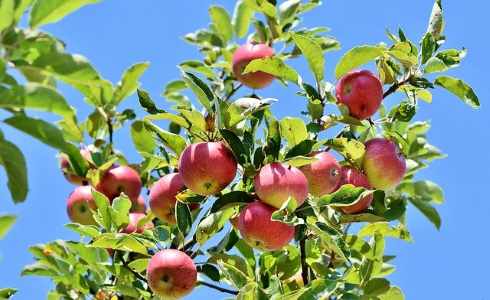
The genus Malus includes apple trees, which have the scientific name Malus domestica. Apple trees are one of the most popular fruit tree varieties to cultivate in your front or backyard. There are an estimated 7,500 apple cultivars to choose from, and apples are a pome type of fruit. ‘Eating apples,’ ‘culinary apples,’ ‘cooking apples,’ or ‘crabapples are all terms used to describe Malus fruits.
Apple fruit trees have a large spread and grow to be between 13 and 40 feet (4 and 12 meters) tall. In the spring, when lovely white blooms bloom on these fast-growing fruit trees, they are stunning. The flowers need cross-pollination in order to produce an apple crop. To get the best outcomes, trees must be planted 100 feet (30 meters) apart. The fruit is ready to be picked between the summer and fall months, depending on the species of apple tree.
In temperate and subtropical regions, apple trees flourish. The types of apples available are also diverse. Light green to dark green skin and crunchy white flesh are found in certain cultivars, such as Granny Smith, Golden Delicious, and Yellow Transparent. Some of the most popular fresh apples include red-skinned varieties like ‘Jonagold,’ ‘Alice,’ ‘Discovery,’ and ‘Fuji.’ Apples are a fruit that has a lot of uses. Some are described as sweet and sour, while others are described as sweet. You may eat apples raw, cooked, or juiced for apple juice or cider.
Apple trees require cold winters for their buds to open in the spring, and they thrive in hardiness zones 3 – 8. Plant on well-draining soil in locations that get plenty of sunlight. Zone 9-10 is home to apple cultivars like Pink Lady, Gala, and Gravenstein.
Dwarf apple trees
Planting a few dwarf apple trees may be beneficial if space in your garden is restricted. Miniature apple trees may be trimmed to make a stunning hedge or small decorative tree when they reach 8 feet (2 meters) in height.
Cherry Trees

When they bloom, some cherry fruit tree species have been developed to be cold hardy. The fruit is a form of drupe and cherries belong to the flowering plant genus Prunus. Flowering cherry trees and cultivated for their fruit are the two most common varieties of cherry trees.
The type of cherries produced by fruit cherry trees is used to classify them. The most popular trees are those that produce sweet cherry fruits. Deliciously sweet cherries include cultivars such as Bing, Rainier, Lambert, and Lapins. These individuals might have pale yellowish-red skin with a dark cherry red coloration.
Sour cherries, such as ‘Montmorency’ and ‘Morello,’ are available in several varieties. Cherry fruit-producing trees are smaller than apple and pear trees. Fruit-bearing cherry trees like ‘Stella,’ ‘Pendula Rosea,’ and ‘Morello’ grow up to 13 feet (4 meters) in height.
Cherry trees of larger varieties may reach a height of 26 to 40 feet (8 to 12 meters). Cherry fruit trees, many of which are cold hardy to zone 5, may be grown in zones 5 and 6. It’s vital to cover the fruit trees with netting in late spring and summer if you’re growing cherry trees for their fruit. This keeps birds from devouring the delicious fruits, ensuring a rich harvest.
You may eat fresh from the tree, preserve them for the winter, or utilize them in recipes with cherry fruits, which are yummy delicious summer snacks. Due to their sour flavor, tart cherries are best used in jams or sweetened to make tart cherry juice. Try dwarf or semi-dwarf cultivars of the most popular cherry trees if you have a small garden.
Quince Trees
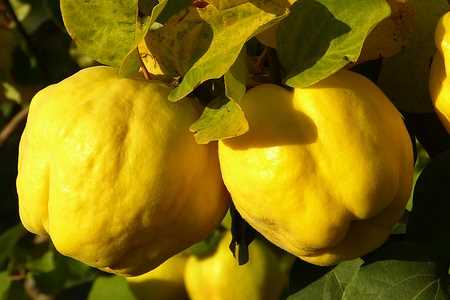
A dwarf quince tree hybrid is a good choice for a tiny garden or a tight area. The astringent and sour flavors of these pome fruits are noticeable. Quince fruit is usually used to make jams or jellies instead of being eaten fresh. Quince fruit has been compared to a pear and a sour apple by some people.
Quinces are the least popular of all the pome fruits that people cultivate in their gardens. The fruit is too bitter for many people, despite the medium-sized fruit tree’s beautiful pink aromatic blooms. The fruit of quince trees may appear like a big apple and grow to be up to 26 feet (8 meters) tall.
Quince trees with dwarf varieties may create lovely fruit-producing bushes or screen shrubs. The quince cultivar Chaenomeles x superba ‘Texas Scarlet’, for example, grows to a height of 4 feet (1.2 meters) and has a spreading of up to 5 feet (1.5 meters).
Citrus Trees

In tropical and subtropical regions, plant several varieties of citrus trees to sample the tremendous fruit variety. Lemons, limes, oranges, grapefruits, and kumquats are examples of citrus fruit trees. The genus Citrus includes citrus trees, which belong to the flowering plant family Rutaceae.
The only way to grow citrus trees indoors is for most people in temperate regions. Thankfully, tiny citrus fruit trees in pots produce little oranges, limes, and lemons, which are ideal for containers. Pomelo, sweet mandarin, and citron are the three main citrus fruits, and all varieties of citrus trees are cultivars or hybrids of them.
Lime trees Little green oval citrus fruit with a pithy sour flavor are produced. In zones 10 through 11, key lime trees (Citrus x aurantiifolia) may grow to a height of 6 to 15 feet (1.8 to 4.5 meters).
Sweet orange trees (Citrus × sinensis) These are the world’s most cultivated fruit trees. They bear spherical orange citrus fruits with a sweet, slightly acidic flavor. Evergreen orange fruit trees reach a height of 30 to 33 feet (9 to 10 meters).
Lemon trees (Citrus x limon) Most people think of citrus trees when they hear the word fruit tree. The zesty yellow rind of lemons is oval or teardrop in shape. Lemon trees reach a height of 15 to 20 feet (4.5 to 6 meters) and are found in zones 9 and 10.
Mini citrus fruit trees or dwarf citrus trees
Calamondin orange (× Citrofortunella microcarpa) is one of the most popular types of mini orange trees. Little citrus fruits, which resemble tiny tangerines but have a strong, sour flavor, are produced by this decorative fruit tree. This mini fruit tree should be cultivated between 55°F and 70°F (12°C and 21°C) indoors.
Apricot Trees
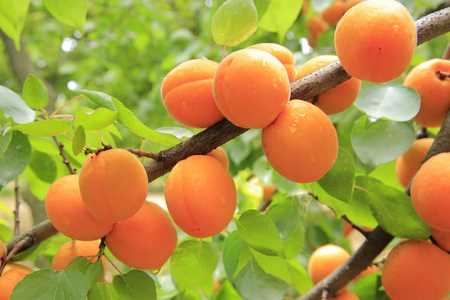
Apricot trees (Prunus armeniaca) produce little stone fruits that are light orange in hue and have a exceptional sweet flavor when fully mature. Little to medium-sized fruit-producing plants known as apricot fruit trees. They can be frost-tolerant and grow in zones 5 through 9.
Apricot trees are popular for their beautiful spring blossoms, in addition to the plethora of sweet fragrant fruits. White blooms with pink and crimson tinges may be seen on the tree.
Because they are self-pollinating trees, apricots need little care. The drupe Apricot is also very versatile. They may be consumed fresh, baked with, or preserved. Dried apricots are a frequent sort of dried fruit in many nations where they can’t be cultivated.
Fig Trees

Some types of fig trees are cold hardy, but others thrive in warm climates. Creepy vines, shrubs, and small trees are all examples of figs. The fruit-producing variety of the common fig plant (Ficus carica) is a common fig plant. These tiny trees, sometimes known as big shrubs, grow to around 10 feet (3 meters) tall and bear fruit.
In the plant kingdom, fig fruits are one of a kind because the blossom develops inside a hollow receptacle. While there are various kinds of figs that turn pale lime green when mature (green figs), the fruit is edible when it changes from green to a deep purple color. The flesh of this exotic fruit is sweet and rich, with little seeds inside. Figs have a strong sweet taste that is characteristic of the fruit. The distinctive shape of the leaves is also used to identify fig trees. Large, dark green fig leaves have deeply lobed edges.
Zone 6 – 9 is the typical location for fig fruit trees. Plant in partially shaded soil to produce figs with pear-shaped fruit. Self-fertile fig trees don’t need cross-pollination, which is another advantage.
Low Maintenance Types of Fruit Trees
You’ll want a kind of easy-to-care-for tree if you have a small garden or want to grow little fruit trees in containers. Self-pollinating fruit trees are the easiest to grow. The greatest low-maintenance fruit trees are listed below.
Low-Maintenance Plum Trees

The plum tree is one of several varieties of fruit trees with a variety of colors and flavors. In temperate regions, these fruit trees produce oval-shaped sweet fruits that thrive. The genus Prunus includes plums, cherries, and peaches, and the botanical name of the genus is Prunus. Plums are a type of fleshy drupe with a single stone in the center.
Many plum tree cultivars yield a variety of fruits, each with its own characteristics. Damons, Victoria plums, greengages, and satsuma plums are some of the varieties of plum trees available. Plum fruits have purple, yellow, green, or red skins depending on the species. The color of the flesh is usually light green, although it isn’t overly juicy.
Plum trees are one of the simplest fruit trees to maintain and tolerate temperatures of zone 5 through 7. Most plum trees, including most of the species, are self-pollinating and require little upkeep to produce fruit. Plum tree is a fantastic investment for any fruit garden because of their compact shape and abundance of sweet oval fruits. Plum trees, including the European plum (Prunus domestica), may be trained to grow to 8 feet (2.4 meters) with proper pruning.
The flavor of plums may range from extremely sweet to acidic, as it does with other fruits in the Prunus genus. The sourest flavor comes from the green skin of some varieties. Plum flesh may be consumed raw, used in preserves, or dried into prunes. In Chinese and Japanese cuisine, Asian varieties of plums are also common.
Pear Trees
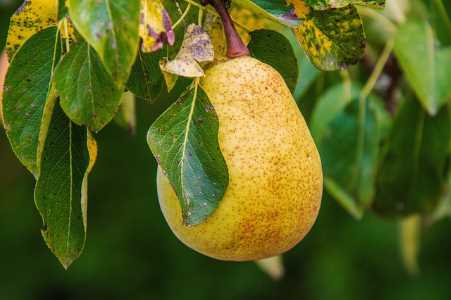
Another kind of fruit tree that is easy to care for is pear trees, which come in a variety of sizes. The genus Pyrus belongs to the Rosaceae family of trees, however they are not apples. Pear fruit is usually soft and juicily, with a seed core. European and Asian pears are the two most common cultivated varieties. The traditional ‘pear form’ is fat and spherical at the bottom, with a point, in European pears (Pyrus communis). The fruit of Asian pear trees (Pyrus pyrifolia) is typically oval in shape.
Most pear species are cold hardy fruit trees, similar to apple trees. There are several dwarf cultivars to choose from, and trees may grow to be up to 56 feet (17 meters) tall. Pollination from distinct cultivars is required for most pear trees to bear fruit, since they are self-pollinating. When pear trees bloom in the spring, they produce stunning white blossoms that are similar to apple blossoms. Pears may have green, red, brown, or yellow skins depending on the species of fruit.
Some cultivars of pear resemble apples, while others are described as “pear-shaped.” ‘Bartlett,’ ‘Red Anjou,’ ‘Comice,’ ‘Concorde,’ and ‘Forelle are some of the most popular pear cultivars that thrive in temperate regions.
Peach Trees
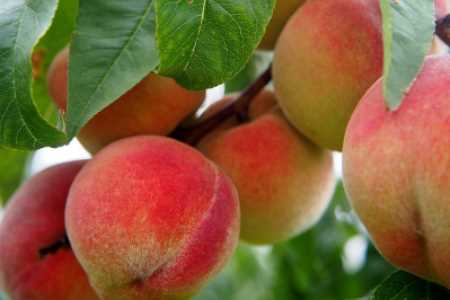
Peach trees are self-pollinating fruit-producing plants that produce reddish or “peach-colored” sweet round fruits in warm climates. Peach fruits (Prunus persica) are comparable to cherries and apricots in appearance. Seek out self-pollinating dwarf cultivars if you want to ensure a high peach yield with little effort.
Peach trees may reach a height of 23 feet (7 meters). Prune them in early spring to keep them manageable and make it easy to choose the delectable exotic fruits. Their height may be kept to around 10 feet (3 meters) during regular care. In the spring before the lanceolate leaves, gorgeous pink blooms bloom on bare stems.
In the mid to late summer, peaches appear on the trees. Each peach tree species may produce between 50 and 150 pounds (23 and 68 kilograms) each year, depending on the species. The sweet flavor of the succulent peach flesh is unmarked by acidity, and it is usually light to dark orange in color.
It’s worth noting that peach and nectarine skins are the only difference between the two. The skin of peaches is hazy, whereas that of nectarines is smooth. While newly developed cultivars are cold hardy, peach trees are not cold-hardy fruit trees. Zones 5 to 9 are the optimum growing conditions.
You may grow a dwarf variety of peach tree in your garden if you don’t have enough room or a balcony. A dwarf peach tree with a bumper harvest of medium-sized peaches, for example, is the Prunus persica ‘Bonanza.’ These little fruit trees are easy to care for and may grow up to 6 feet (1.8 meters) tall.
